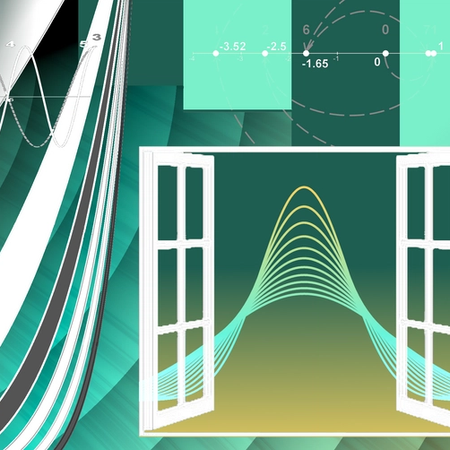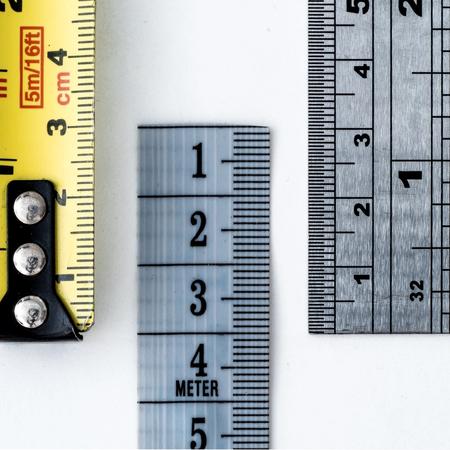“God made the integers; all else is the work of man” — Leopold Kronecker
Number line
We’re all familiar with a meter stick. They are handy for measuring things—until we can’t find one. One more reason I like math is I don’t lose things in my abstract world. Those of you who are familiar with CS Lewis and “The Lion, the Witch, and the Wardrobe” likely know about Narnia. Narnia is an alternative world where time essentially stood still. Truth was uncovered in Narnia, but it came from things that were made up. To me, math is like Narnia. It is a wonderful world where truth is revealed but from things that are just made up. So, for the sake of adventure, I invite you to think of math as a place like Narnia. It is a world of adventure, but it is a world that we have made up. Like Narnia, though, it can reveal profound truths.
The real world has a meter stick. We enter this made-up math world by abstracting a meter stick into a number line. Abstracting things has its advantages. Not only do we never lose number lines, but we can scale them to however big or small we want. Here is a number line where we highlight the segment from 0 to 3.

Usually, we label a number line with integers, which are numbers we use to count, such as 0, 1, 2, etc. The integers could represent centimeters or millimeters. When we abstract things, we often ignore what they represent. They’re now just abstract things we call numbers.
Thus, we can take these numbers and divide them into pieces that we name fractions. For example, the number line below highlights the segment from 0 to 3 divided into smaller segments of each. We can start to think of fractions as having two components: the whole and the part. Think of a pizza that is cut into 2 equal parts. The whole is the entire pizza, which contains 2 parts. If we get 1 piece, then we get of the pizza. If we don’t want to write this number as a fraction, we simply take the part and divide it by the whole, or 1 divided by 2 in this case, which is 0.5. After we get good at thinking of fractions as a part and a whole, we tend to just abstract it even more and think of it as simply a fancy way to write a division expression. See how easy it is to make up stuff in this abstract world?

Why stop at dividing integers into halves? We could also divide them into thirds, fourths, and keep going until we get tired. Below, we divided the number line between 0 and 3 into 10 and then 12 equal parts. If all this seems trivial to you, it is because you have been living in this abstract world long enough that it feels real. Don’t underestimate the huge task it is to arrive at that place. Many people are never able to make it that far. Entering our made-up world of a number line requires some imagination. If this number line makes sense to you, friend, you are in. You have what it takes to do math.

Two worlds in conflict
Notice as we divide a number line into parts and identify one of the parts, what we’re doing is identifying a point on a line. What does that mean? A point is something discrete, something we can count. We may have one point or two points. We count points. A line is something we measure; it is continuous. Already, we’ve uncovered an issue. We may be tempted to ask how many points there are on a line. After all, a line consists of points. But this question doesn’t seem to make sense. It leads us to think we have two worlds in conflict—what we count and what we measure. We count points and we measure lines. Both of these worlds exist on a number line. How can we reconcile these two worlds?
You may not have thought about this conflict before. We can’t count how much rain we have received, but we can measure it. We don’t measure how many days remain in the week; we count them. Now, think of a number line. We measure the distance across a number line, but a number line consists of a collection of points which we count. How do we reconcile the ability to count and measure on a number line? When do the collection of points create a line? How many points do we need until we create a line? In the physical world, perhaps the answer is when we get enough points so they touch each other, the collection of points create a line. But, in the abstract world, we’re not limited by the size of the point.
We don’t reconcile this problem by force. Force may be a method in the real world that allows us to use power or resources to make things happen. The method of force never works in math. We can never force a solution. No matter who you are in this math world, you cannot state something is true just because you are smart or have accomplished something great. The math world does not operate that way. Rather, the way conflict is reconciled in math is by reasoning. We start by thinking of a number line as a collection of dots that we can count. But at what point can we transition from counting dots to measuring the length of a line segment?
This is how Euclid thought of this. Euclid defined a point as “that which has no parts.” We can translate this as a point has zero dimensions. A line contains an infinite number of points. We think of a straight line as one-dimensional. Notice the transition. We collect an infinite number of zeroes, form them “together” in order, and something one-dimensional is created. Pretty profound when you think about it.
Perhaps you think this is only a trivial question, an interesting one but not important. Actually, there is a huge amount of math that depends on this issue being managed correctly. For example, calculus is built on what happens between this world of what we count and what we measure.
Calculus often thinks about this in reverse order than we just did. Calculus starts with a line rather than a point. Then, it divides the line into smaller segments, even though we know no matter how small the line is, it still contains an infinite number of points. But, if we allow this idea of cutting a line into smaller parts to “continue forever,” then we say that we “approach” a single point. Again, all this may seem very abstract, which it is. But we use the results of calculus every day, so these ideas are consistent with the physical world. But they are all built on trying to connect these two worlds.
An example to illustrate this concept is when we read how fast we are driving from the dashboard of our car. It may state something like 65 miles per hour. We think of that as how fast we are traveling at one moment or one point in time—like a snapshot. But we are not moving in a snapshot. In a moment of time that is frozen, we’re not moving. So how can we conclude we are moving 65 miles per hour at a point in time? That is where calculus steps in to make sense of it all.
Ironically, calculus was “created” and used for centuries without this firm foundation of “approaching” established. It wasn’t until the late 19th century that the foundation for calculus was set firm. Our focus won’t be so much on formal calculus theory, but we will often do battle in Lazarus Math with these two conflicting worlds.
How many positive integers?
For now, let’s continue thinking about the idea of what we count and what we measure and how they exist on the number line. Consider the number line that is right of 0. How many points will we find on this line? It seems like a lot. Even if we just think of the integers 1, 2, 3, etc., you likely know that we have an infinite number of these integers. This may seem like common sense, but remember we can’t force math. Just because we think it is true doesn’t make it true. So how do we know for sure that there are an infinite number of positive integers?
Let’s attempt to prove this seemingly common idea that there are an infinite number of positive integers. How can we prove there are an infinite number of something? A more basic question is how can we prove anything in math? You may be surprised, but we use a technique that has been used throughout history to reveal deep truths. We tell stories. Religious people use stories to share truth. Humans historically use stories to expose deep emotions. Simple words usually are not sufficient. For the really important things in life, we often prefer to use stories. The stories used in proofs are stories of reason and logic, not the “story problems” we see in a text book. We are free to create any story we want as long as it follows reason and logic.
In order to prove that there are an infinite number of integers, we use a favorite method for proving something in math. We pretend the story is not true. Then, we follow the story to where it logically leads until we succeed or crash. If we use sound logic along the way and crash, then our assumption that the story is not true is wrong, and thus the story must be true. This only works for stories (statements) that are either true or false; no gray area here.
Our story is there are an infinite number of integers. We want to prove our story is true. Clearly, there either is an infinite number of integers or there isn’t, so this meets our true/false criterion. If we assume our story is false, then there are a finite number of integers. So let’s follow this story and see where it leads by assuming there are a finite number of integers. If there are a finite number of integers, there must be one last integer. That is what it means to be finite. There is an end. We presumably don’t have a label for this last integer, so let’s simply refer to this last integer as . Because is an integer, we can perform on it a rule of addition that applies to all integers. One rule of addition is I can add 1 to and create another integer, and this integer is larger than . Notice we assumed was the largest integer but we just created an integer larger than . That means our story ran into a train wreck and crashed. We created a contradiction: is the largest integer but there is an integer larger than (which we created by using a property that applies to all integers). Thus, we must backtrack to see where we went wrong. Our logic was sound after our initial assumption. The only part that did not follow from reason was our assumption. That must mean our assumption that there are a finite number of integers must be false. There, we just proved there are an infinite number of integers. Sometimes math can be that easy. Now that you know the proof, it seems almost trivial. Even though it is simple, I think it is pretty clever.
This isn’t the only way to prove there are an infinite number of integers. There are other stories we can tell to arrive at the same conclusion. But we cannot create a math story that arrives at a different conclusion if we start with the same assumptions. Notice how different this is from the real world. For example, if two people have a conflict and both share their stories, sometimes we could conclude that both are right. That is because each has a story from a different perspective. Because the stories are from different perspectives, we could conclude that both are correct from their perspectives. That is one of the neat things about math. Even though there are a lot of different paths to travel on a proof, they all arrive at the same conclusion if they start at the same place. That may not seem meaningful in our example of proving that there are an infinite number of integers because we had a strong intuition before we started that it was true. But there are many ideas in math where there is not a strong intuition bias. Actually, there are cases where there is strong intuition and the intuition ends up being wrong.
There is something almost humorous going on if you stop and think about it. One reason to do math is to always be searching for a different way to prove something. Math people love inventing new stories that arrive at the same conclusion. Why would math people do such a thing? We just learned that we will not arrive at a different conclusion. So why should we pursue more than one proof? The humor here is math people look for different stories not because they are searching for a different conclusion, but because they are searching for a different journey to end at the same destination. This highlights that for proofs, the journey is just as important or sometimes more important than the destination. There are some things in math that have been proven a hundred different ways by math people from different cultures and different centuries. All are smart people who find it worth their time to identify one more interesting way to arrive at the same conclusion. In some sense, math people do “reinvent the wheel!”
This is where math people are more artist than scientist. They are always looking for something beautiful. Usually, the goal is the simpler the better. You may think math people like to pursue complexity because it seems like we often make things difficult. But, in reality, doing math is pursuing the simplest solution possible. If nothing else, math people believe that simple is beautiful. As GH Hardy stated in the introductory quote, “Beauty is the first test: there is no permanent place in the world for ugly mathematics.” Math is a process of not only telling stories but searching for beautiful stories, and the simpler the better. Our math comes alive when we, like a painter, realize we not only have tremendous freedom to do our craft but we can also create something beautiful. And math is beautiful.
Now that we have a sense of what a math proof is, let’s return to our journey through a number line.
Rational numbers
Since we have an infinite number of integers, we have an infinite number of whole things. Recall we split the number line into fractions like cutting a whole pizza into slices. Let’s only consider fractions where both the numerator and denominator are integers. This is how we begin to think of fractions with a part and a whole. Remember we just concluded that there are an infinite number of integers.
Since this process of dividing a whole into parts is essentially working with integers, we can repeat this process an infinite number of times. In fact, we can make an infinite number of divisions even just between the numbers 1 and 2.
We can also think of fractions as ratios, and from the word ratio we get the word rational. We use this idea of a part and a whole to create a rational number. A rational number is any number that we can write as , where and are both integers and is not 0. Yes, there are an infinite number of rational numbers between, for example, 1 and 2.
Now that we have this limitless collection of rational numbers, let’s return to our conflict of identifying how to create a line from a collection of dots. Are the rational numbers enough to “connect the dots” and create a line? Will this infinite collection of numbers join what we count to what we measure? For example, we noted that there are an infinite number of rational numbers even between 1 and 2. It seems like this infinite collection of points (representing the rational numbers) between 1 and 2 will create a line because it is crowded on that number line. These rational numbers clearly are not practicing social distancing. But, as we draw a line from 1 to 2, are there dots in this line that are not rational numbers? In other words, are there other numbers on the number line between 1 and 2 that are not rational?
Before we answer this question, let me first highlight our restriction that the b cannot be 0. Rather than considering this as a rule you must accept and memorize, I encourage you to consider why we don’t allow b to be 0. There are many reasons this gets us in trouble. I will share one reason. If we consider the fraction where we take and divide it into parts, does it make sense to divide into 0 parts? After you have given this some thought, let’s return to the main question at hand. Is there room for any other numbers on our number line other than rational numbers?
A number game
To answer this question, let’s play a game.
I will choose a number between 1 and 2. It is your job to guess the number. The rule is you divide a segment into equal parts and then I indicate which part my number is in. You have two rules in this game that are in your favor. Both rules give you an infinite number of options.
The first rule is you can choose how big each “part” is. For example, you may choose to divide the segment into 2 equal parts, 5 equal parts, 10 equal parts, etc. Clearly, you have an infinite number of choices since there are an infinite number of integers.
The second rule is you can perform this exercise any number of times until you arrive at the answer. Thus, in theory, you could perform this equal division an infinite number of times.
This is one way this game could be played. Assume my number is 1.123 and assume you divide the interval into 10 equal parts. Then the segments would go from 1.0 to 1.1, from 1.1 to 1.2, etc., and from 1.9 to 2.0. Given these segments, I would specify that the number is in the segment from 1.1 to 1.2. Then, you repeat the process and divide this segment into 10 equal parts from 1.1 to 1.11, from 1.11 to 1.12, etc., and from 1.19 to 1.20. Now, my number is in the segment from 1.12 to 1.13.
Then, we repeat this process once more and you would arrive at the number 1.123. The game would end and you win. But is there a number between 1 and 2 that I can choose that you will never find using this process? The answer to this question is yes, there is at least one number. Not only is there such a number, but this number is easy to identify.
Two power tools are not enough
Think about this concept for a moment. We described two powerful tools at our disposal to identify a certain number between 1 and 2. Both are unlimited in capacity to make a width as small as we would like. But I’m claiming that there is a known number that exists that you will not identify even with infinite options at your disposal. I’m also claiming that it is easy for me to determine a number so that I win the game.
Don’t these two claims seem absurd? They certainly don’t appear, well, rational. Let’s identify how math can surprise us with an answer that is not rational yet true.
We will identify this number by using principles from high school geometry. Start with a segment from 0 to 1. Then, create a square with each side having length 1. This is easy enough to imagine. We can return to our number line and draw the first side from 0 to 1. Then, we can extend both end points up the same distance so that both segments are perpendicular to the first. (Of course, this step is required to create a square.) Then, finish the square by connecting the two end points that result from these perpendicular segments. If we think of this square residing on an -coordinate system, then the corners of the square rest at (0,0), (1,0), (0,1) and (1,1). This doesn’t appear to be a big step anywhere important. Yet, we are only one clever move from arriving at a number that is not rational.
The clever move that remains is rotating and preserving symmetry. So let’s rotate the square while keeping it symmetrical. We could rotate the square completely around but we would arrive where we started and it wouldn’t feel like progress. Likewise, we could rotate it halfway around, or even 1/4 of the way around, and it would still look like the same square. But consider rotating the square a half of a half of a half, or 1/8, of a rotation. You may view this rotation in the graph below.
Since we assigned one corner of the square (0,0), that seems like the logical point to lock in place when we rotate. Now, we have the same square as before, but it appears different on our coordinate system. Certainly, we know this square exists. After all, if we can’t create a square of length 1, we won’t get too far in math.
Notice at the end of the rotation, we have two corners of our square on our original number line. Then, it is only natural to ask about the distance between these two points. This should not be difficult. What could be simpler than a square of length 1? It seems reasonable to ask, “What is the distance between opposite points of the square?” As odd as it may seem, we just created a segment whose length we cannot identify using our rational division method. If this idea is new to you, perhaps you are skeptical of this claim. We will actually prove later in Lazarus Math that this segment has a length that is not rational. For now, just contemplate this interesting idea.
So, if we played our game again and you again chose to divide the segment 1 to 2 into 10 equal parts, then this number would be between 14/10 and 15/10, or the decimal equivalent 1.4 and 1.5. We can see that the length of the diagonal of the square is in this segment. Then, we take the segment between 1.4 and 1.5 and divide it into 10 equal parts, and we would find our diagonal rests between 1.41 and 1.42. We would simply continue this process for as long as needed until we identified a segment that was exactly equal to our diagonal. It sure seems like we would eventually find that segment. The stark reality is we won’t. Isn’t it interesting that we created this number that is not rational just by using a simple square with length 1?
What is this number that is not rational?
This is not the only example of a number we can create that is not rational. There are many other examples. Of course, we have a name for these types of numbers. Not surprisingly, we refer to them as irrational numbers. Irrational numbers form their own set of numbers. You may be curious what the irrational number is that we identified with our square of length 1.
Perhaps you recall from high school geometry that if the length of the hypotenuse of a right triangle is c and the length of the other two sides are a and b, then we can write this formula that connects these lengths: . If we divide the square in half, we clearly have a right triangle since the angle of all 4 sides of a square is 90 degrees. Since we defined the length for all sides of the square as length 1, we know . By substitution, we can write . Then, we simplify and rearrange to get . Next, we take the square root of both sides to get . Technically, we would need to consider the negative root as well, but we don’t need to because a distance cannot be negative.
This means we are claiming that is an irrational number. If is rational, then we can write for some integers and . But, since is not rational, then an integer value for and does not exist.
The danger of irrational numbers
This discussion of irrational numbers may seem interesting, but is it important? In many respects, the answer is yes, it is important. For a long time, we thought there were only rational numbers. In fact, there is a story about someone who claimed that there was a number that wasn’t rational. He was killed for making such a claim. Who would kill a person simply for stating a number is not rational?

The evidence points to Pythagoras (570 − 495 BC) and his crew. Pythagoras? Ironically, he is the same person connected to the Pythagorean theorem we just used. Whether he actually killed someone is not certain. But what is certain is that Pythagoras and his crew were not the calm math geeks you may have envisioned. Why would Pythagoras and his crew actually kill or even consider killing over the existence of an irrational number?
First, we need to understand the context of who these people were. The Pythagoreans, as they were called, considered numbers as a gift from the gods, and they took their numbers seriously. In fact, they concluded that everything was numbers and the only numbers we have are those we create from integers, i.e., the rational numbers. They noticed good music came from patterns of these numbers. (Later in Lazarus Math, we will peek further into this story of how Pythagoras connected numbers to music.) The Pythagoreans weren’t a crew of people who considered math a mere subject. Math was life. It had a cult-like following. Some have compared the followers of Pythagoras to the followers of Jesus. They went to bat for Pythagoras like religious zealots whose religion was based on rational numbers.
Now, imagine a cult of people who took integers very seriously and the shock they must have experienced when one of the most basic shapes we can think of, a square, produces a number that is not rational. The Pythagoreans prided themselves in being experts in math. Now, imagine them measuring the length of the diagonal for this basic simple shape. They could not express this distance as the ratio of two integers. This was a real distance that they could not explain with the numbers known at that time, which were the numbers they treated as gifts from the gods. I’m sure they believed the number existed somewhere, but they just couldn’t identify it. Then imagine one of their members not only states that the number doesn’t exist in the known numbers but can prove it. What a problem that must have been for the Pythagoreans!
The idea that there is a number that is not rational was, and still is, a big deal.
Because there are an infinite number of integers and we create rational numbers from integers, we know we have an infinite number of rational numbers. However, how many irrational numbers are there? A thousand, a million, a billion? Would you believe an infinite number? There are even an infinite number of irrational numbers between 1 and 2. In fact, you could choose any two numbers and there are an infinite number of rational numbers and an infinite number of irrational numbers between those two numbers. Oh, we thought our number line was filled with rational numbers. Where do these new numbers fit? The irrational numbers also fit on that number line.
Comparing rationals and irrationals
Now, consider this question: do we have more rational numbers or irrational numbers between 1 and 2? Who knows? Math people know, that’s who.
What would you guess? It is an odd question, for sure. Though it was quite easy to imagine rational numbers, it seems like we had to search far and wide for an irrational number. We created a long story just to identify a single irrational number. So intuition would indicate there are more rational numbers than irrational numbers. It turns out there are actually more irrational numbers than rational numbers. Did you see that coming?
Think about what we’re saying. We’re saying one infinity, the number of irrational numbers, is more than another type of infinity, the number of rational numbers. That’s heavy and enough to make our heads spin. It’s like two young boys debating how long it will be until they get a girlfriend. A hundred years. No, a thousand years. A billion years. A billion billion. An infinite number of years. An infinite number times 2?
What else do we know about irrational numbers? We know that if we write them in a decimal format, they contain an infinite number of digits and there is no pattern that repeats. Contrast this with rational numbers. We can write every rational number, either exactly as a decimal, such as ½ equals 0.5, or as a repeating decimal, such as that has an infinite number of digits in the decimal but has a pattern that repeats, namely 3. There could be more complicated patterns, such as Irrational numbers don’t have that pattern. Like the Energizer Bunny, irrational numbers just keep going and going and going but never repeat.
Before we finish, let’s talk about what exactly represents. How do we know it’s a number? We know we can create a segment that has this length, so we should include it in our number line. Think back to our definition of an irrational number. An irrational number is a number that is written in decimal format with an infinite number of digits that never repeat. That means we cannot exactly write in decimal format what this number is. Sure, we can get a result from our calculator if it has a square root function. But that is only an approximation.
So think of this number that represents a distance we can quantify exactly but cannot state exactly in decimal format. Isn’t that interesting? Further, even though we can’t state this number in decimal format exactly, if we multiplied this number (which has an infinite number of digits) by itself, we would get the number 2 exactly. When I think about these things, it is a bit mind-boggling!
Putting it together
Did you enjoy our mini journey in the Narnia of a number line? We uncovered some remarkable ideas simply by thinking about this line. From it, we identified there are an infinite number of integers and rational numbers. Notice integers are a subset of rational numbers since they can be written as a fraction with denominator 1. Then we uncovered a real gem in the irrational numbers.
A rational number is a number that we can write as , where and are integers and is not 0. The rational numbers form an infinite set.
An irrational number cannot be written as a rational number. But it is a number that is a solution to an equation such as , which we could rewrite as . There are an infinite number of irrational numbers. Even more impressive is there are more irrational numbers than rational numbers. The irrational numbers form another set.
It’s only a small step from here to create a third set of numbers called the real numbers. We get the set of real numbers by just combining the set of rational numbers and the set of irrational numbers. As a result, if we order the rational numbers and irrational numbers together, smallest to largest, and “connect the dots," we create the number line of real numbers. You probably didn’t realize you were creating so many dots and so many connections the last time you drew a number line!
What we accomplished is no small task. If we take any measurement on a number line of real numbers, we know every possible distance we could measure is either a rational number or an irrational number. Math people have proven there is not a missing third set out there.
The real numbers are a permanent fixture in math that will never change. So, rest assured, there is not another type of positive real number out there that has not been discovered.










